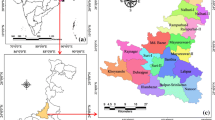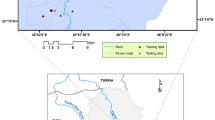Abstract
In arid and semi-arid, due to the lack of surface water, groundwater plays key role in people survival. Therefore, assessing groundwater potential zones is vital to conserve and manage this resource properly. The main object of this study was to compare two methods of AHP and entropy for delineating groundwater potential zone in arid region of Iran. For this regard, withdraw in groundwater level in 16 piezometer wells along with eight GWP conditioning factors of slope degree, stream power index (SPI), landuse, geology; rainfall volume, elevation, soil and lineament density have been considered in the training process while the discharge in the other 16 wells was involved in verifying process of the two models. GWP maps were provided by overlaying all the thematic maps in terms of the obtained weights from AHP and entropy methods. Finally, the models performance was compared through statistical measures of Sensivity, Specificity and True Skill Statistics (TSS). The results show that IOE model (TSS = 0.16) have higher prediction performance than AHP approach (TSS = 0). Therefore, IOE was more promising tools for GWP modeling.








Similar content being viewed by others
References
Abu-alnaeem MF, Yusoff I, Fatt NTF, Alias Y, Raksmey M (2018) Assessment of groundwater salinity and quality in Gaza coastal aquifer, Gaza Strip, Palestine: An integrated statistical, geostatistical and hydrogeochemical approaches study. Sci Total Environ 615:972–989
Acharya T, Nag SK (2013) Study of groundwater prospects of the crystalline rocks in Purulia District, West Bengal, India using remote sensing data. Earth Resources 1(2):54–59
Al-Abadi AM, Pourghasemi HR, Shahid S, Ghalib HB (2017) Spatial mapping of groundwater potential using entropy weighted linear aggregate novel approach and GIS. Arab J Geosci 42(3):1185–1199
Allouche O, Tsoar A, Kadmon R (2006) Assessing the accuracy of species distribution models: prevalence, kappa and the true skill statistic (TSS). J Appl Ecol 43(6):1223–1232
Andualem TG, Demeke GG (2019) Groundwater potential assessment using GIS and remote sensing: a case study of Guna tana landscape, upper blue Nile Basin, Ethiopia. J Hydrol Reg Stud 24:100610
Arulbalaji P, Padmalal D, Sreelash K (2019) GIS and AHP techniques based delineation of groundwater potential zones: a case study from southern western Ghats, India. Sci Rep 9(1):1–17
Ashrafzadeh A, Roshandel F, Khaledian MR, Vazifedoust M, Rezaei M (2016) Assessment of groundwater salinity risk using kriging methods: a case study in northern Iran. Agric Water Manag 178:215–224
Bhattacharya S, Das S, Das S, Kalashetty M, Warghat SR (2020) An integrated approach for mapping groundwater potential applying geospatial and MIF techniques in the semiarid region. Environ Dev Sustain:1–16
Bui DT, Hoang ND, Martínez-Álvarez F, Ngo PTT, Hoa PV, Pham TD, Samui P, Costache R (2020) A novel deep learning neural network approach for predicting flash flood susceptibility: a case study at a high frequency tropical storm area. Sci Total Environ 701:134413
Chen CY, Chang JM (2016) Landslide dam formation susceptibility analysis based on geomorphic features. Landslides 13:1019–1033
Chitsaz N, Azarnivand A (2016) Water scarcity management in arid regions based on an extended multiple criteria technique. Water Resour Manage:1–18
Constantin M, Bednarik M, Jurchescu MC, Vlaicu M (2011) Landslide susceptibility assessment using the bivariate statistical analysis and the index of entropy in the Sibiciu Basin (Romania). Environ Earth Sci 63:397–406
Das B, Pal SC, Malik S, Chakrabortty R (2019) Modeling groundwater potential zones of Puruliya district, West Bengal, India using remote sensing and GIS techniques. Geol Ecol Landscapes 3(3):223–237
Dinesh Kumar PK, Gopinath G, Seralathan P (2007) Application of remote sensing and GIS for the demarcation of groundwater potential zones of a river basin in Kerala, southwest cost of India. Int J Remote Sens 28(24):5583–5601
Dingman LS (2015) Physical hydrology. Waveland press Inc.
Elgettafi M, Elmandour A, Himi M, Casas Ponsatí A, Elhaouadi B (2012) Messinian salinity crisis impact on the groundwater quality in Kert aquifer NE Morocco, hydrogeochemical and statistical approaches. Int J Water Resour Environ Eng 4(11):339–351
Fukuda S, De Baets B, Waegeman W, Verwaeren J, Mouton AM (2013) Habitat prediction and knowledge extraction for spawning European grayling (Thymallus thymallus L.) using a broad range of species distribution models. Environ Modell Softw 47:1–6
Guru B, Seshan K, Bera S (2017) Frequency ratio model for groundwater potential mapping and its sustainable management in cold desert, India. J King Saud Univ Sci 29(3):333–347
Habibi V, Ahmadi H, Jafari M, Moeini A (2019) Application of nonlinear models and groundwater index to predict desertification case study: Sharifabad watershed. Nat Hazards (Dordr) 99(2):715–733
Hardcastle KC (1995) Photolineament factor: a new computer-aided method for remotely sensing the degree to which bedrock is fractured. Photogramm Eng Remote Sensing 61(6):739–747
Jamshidzadeh Z, Mirbagheri SA (2011) Evaluation of groundwater quantity and quality in the Kashan Basin, Central Iran. Desalination 270:23–30
Jha MK, Chowdhury A, Chowdary VM, Peiffer S (2007) Groundwater management and development by integrated remote sensing and geographic information systems: prospects and constraints. Water Resour Manag 21:427–467
Kaur L, Rishi MS, Singh G, Thakur SN (2020) Groundwater potential assessment of an alluvial aquifer in Yamuna sub-basin (Panipat region) using remote sensing and GIS techniques in conjunction with analytical hierarchy process (AHP) and catastrophe theory (CT). Ecol Indic 110:105850
Khoshtinat S, Aminnejad B, Hassanzadeh Y, Ahmadi H (2019) Groundwater potential assessment of the Sero plain using bivariate models of the frequency ratio, Shannon entropy and evidential belief function. J Earth Syst Sci 128(6):152
Khosravi K, Panahi M, Tien Bui D (2018) Spatial prediction of groundwater spring potential mapping based on adaptive neuro-fuzzy inference system and metaheuristic optimization. Hydrol Earth Syst Sci 22:4771–4792
Kindie AT, Enku T, Moges MA, Geremew BS, Atinkut HB (2018) Spatial analysis of groundwater potential using GIS based multi criteria decision analysis method in Lake Tana Basin, Ethiopia, In international conference on advances of science and technology. Springer, Cham, pp 439–456
Kumar VA, Mondal NC, Ahmed S (2020) Identification of groundwater potential zones using RS, GIS and AHP techniques: a case study in a part of Deccan volcanic province (DVP), Maharashtra, India. J Indian Soc Remote Sens:1–15
Ledesma-Ruiz R, Pastén-Zapata E, Parra R, Harter T, Mahlknecht J (2015) Investigation of the geochemical evolution of groundwater under agricultural land: a case study in northeastern Mexico. J Hydrol 521:410–423
Lee S, Hong SM, Jung HS (2018) GIS-based groundwater potential mapping using artificial neural network and support vector machine models: the case of Boryeong city in Korea. Geocarto Int 33(8):847–861
Lee S, Kim YS, Oh HJ (2012) Application of a weights-of-evidence method and GIS to regional groundwater productivity potential mapping. J Environ Manag 96:91–105
Li P, Wu J, Qian H (2016) Hydrochemical appraisal of groundwater quality for drinking and irrigation purposes and the major influencing factors: a case study in and around Hua County, China. Arab J Geosci 9(1):1–17
Lu GY, Wong DW (2008) An adoptive inverse-distance weighting spatial interpolation techniques. Comput Geosci-UK 34:1044–1055
Machiwal D, Rangi N, Sharma A (2015) Integrated knowledge and data-driven approaches for groundwater potential zoning using GIS and multi-criteria decision making techniques on hardrock terrain of Ahar catchment, Rajasthan, India. Environ Earth Sci 73(4):1871–1892
Magesh NS, Chandrasekar N, Soundranayagam JP (2012) Delineation of groundwater potential zones in Theni district, Tamil Nadu, using remote sensing, GIS and MIF techniques. Geosci Front 3:189–196
Mogheir Y, De Lima JLMP, Singh VP (2005) Assessment of informativeness of groundwater monitoring in developing regions (Gaza strip case study), water Resour. Manage 19:737–757
Mohammadi F, Ehteshami M, Mirbagheri SA, Tavassoli S (2017) Monitoring groundwater and its suitability for drinking and irrigation purposes in the Sharif Abad Basin, Central Iran. World J Eng Technol 5(3):487–506
Naghibi SA, Pourghasemi HR, Pourtaghi ZS, Rezaei A (2015) Groundwater qanat potential mapping using frequency ratio and Shannon’s entropy models in the Moghan watershed, Iran. Earth Sci Informatics 8:171–186
Nguyen PT, Ha DH, Jaafari A, Nguyen HD, Van Phong T, Al-Ansari N, Prakash I, Le HV, Pham BT (2020) Groundwater Potential Mapping Combining Artificial Neural Network and Real AdaBoost Ensemble Technique: The DakNong Province Case-study, Vietnam. Int J Environ Res Public Health 17(7):2473
Ozdemir A (2011) GIS-based groundwater spring potential mapping in the Sultan Mountains (Konya, Turkey) using frequency ratio, weights of evidence and logistic regression methods and their comparison. J Hydrol 411:290–308
Pinto D, Shrestha S, Babel MS, Ninsawat S (2017) Delineation of groundwater potential zones in theComoro watershed, Timor Leste using GIS, remote sensing and analytic hierarchy process (AHP) technique. Appl Water Sci 7:503–519
Pourghasemi HR, Beheshtirad M (2015) Assessment of a data-driven evidential belief function model and GIS for groundwater potential mapping in the Koohrang watershed, Iran. Geocarto Int 30:662–685
Pourtaghi ZS, Pourghasemi HR (2014) GIS-based groundwater spring potential assessment and mapping in the Birjand township, southern Khorasan Province, Iran. Hydrogeol J 22:643–662
Razandi Y, Pourghasemi HR, Neisani NS, Rahmati O (2015) Application of analytical hierarchy process, frequency ratio, and certainty factor models for groundwater potential mapping using GIS. Earth Sci Informatics 8:867–883
Saaty TL (1980) The analytic hierarchy process. Mc Graw Hill Company, New York
Shaban A, Khawlie M, Abdallah C (2006) Use of remote sensing and GIS to determine recharge potential zones: the case of occidental Lebanon. Hydrogeol J 14(4):433–443
Shahid S, Nath S, Roy J (2000) Groundwater potential modeling in a soft rock area using a GIS. Int J Remote Sens 21(9):1919–1924
Sisay L (2007) Application of remote sensing and GIS for groundwater potential zone mapping in northern Ada’a plain (Modjo catchment) university. Addis Ababa University
Thapa R, Gupta S, Guin S, Kaur H (2017) Assessment of groundwater potential zones using multi-influencing factor (MIF) and GIS: a case study from Birbhum district, West Bengal. Appl Water Sci 7:4117–4131
Theil H (1972) Statistical decomposition analysis. North-Holland Publishing Company, Amsterdam
Vengosh A, Kloppmann W, Marei A, Livshitz Y, Gutierrez A, Banna M, Raanan H (2005) Sources of salinity and boron in the Gaza strip: natural contaminant flow in the southern Mediterranean coastal aquifer. Water Resour Res 41(1)
Wu J, Sun Z (2016) Evaluation of shallow groundwater contamination and associated human health risk in an alluvial plain impacted by agricultural and industrial activities, mid-West China. Expo Health 8(3):311–329
Xu C, Xu X, Dai F, Xiao J (2012) Landslide hazard mapping using GIS and weight of evidence model in Qingshui River watershed of 2008 Wenchuan earthquake struck region. J Earth Sci 23(1):97–120
Yufeng S, Fengxiang J (2009) Landslide stability analysis based on generalized information entropy, 2009 International Conference on Environmental Science and Information Application Technology, pp 83–85
Zare M, Pourghasemi H, Vafakhah M, Pradhan B (2013) Landslide susceptibility mapping at Vaz watershed (Iran) using an artificial neural network model: a comparison between multilayer perceptron (MLP) and radial basic function (RBF) algorithms. Arab J Geosci 6(8):2873–2888
Acknowledgements
I would like to thank Qom Regional Water Company helping us to provide information for this research.
Availability of data and materials
If it is necessary, we will send used data.
Author information
Authors and Affiliations
Corresponding author
Ethics declarations
Declarations
The authors declare that they have no known competing financial interests or personal relationships that could have appeared to influence the work reported in this paper.
Conflicts of interest/competing interests
Not applicable.
Ethics approval
Not applicable.
Consent to participate
The authors are satisfied to participate in this research.
Consent for publication
We sent this article for publishing in this journal.
Code availability
Not applicable.
Additional information
Communicated by: H. Babaie
Publisher’s note
Springer Nature remains neutral with regard to jurisdictional claims in published maps and institutional affiliations.
Rights and permissions
About this article
Cite this article
Forootan, E., Seyedi, F. GIS-based multi-criteria decision making and entropy approaches for groundwater potential zones delineation. Earth Sci Inform 14, 333–347 (2021). https://doi.org/10.1007/s12145-021-00576-8
Received:
Accepted:
Published:
Issue Date:
DOI: https://doi.org/10.1007/s12145-021-00576-8




